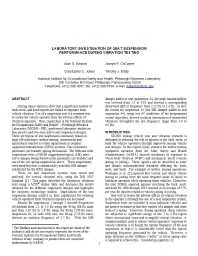Mining Publication: Laboratory Investigation of Seat Suspension Design Performance during Vibration Testing
Original creation date: November 2006
Mining injury statistics show that a significant number of back, neck, and head injuries are linked to exposure from vehicle vibration. Use of a suspension seat is a common way to isolate the vehicle operator from the adverse effects of vibration exposure. Thus, researchers at the National Institute for Occupational Safety and Health - Pittsburgh Research Laboratory (NIOSH - PRL) performed laboratory studies on four passive and two semi-active seat suspension designs. These are typical of seat suspensions commonly found on large off-road heavy surface mining, construction and agricultural vehicles as either replacement or original equipment manufacturer (OEM) systems. One included a pneumatic (air bladder) spring mechanism. The fifth and sixth suspensions were a NIOSH magnetorheological (MR) semi-active damper design based on the pneumatic (air bladder) and one of the coil spring suspensions above. These suspensions were modified with a commercially available MR damper substituted for the OEM damper. These six seat suspension systems were tested and analyzed, for vertical vibration only, using the ISO 5007 Standard. This paper describes the laboratory vibration tests using a MTS® shaker table and discusses the results obtained for the different suspension designs and highlights the rheonetic technology studied. Implications of the seat suspension designs relative to their capabilities for isolating vehicle operators from vibration exposure are discussed. Results for suspensions 1 through 3 showed frequencies of isolation from 2.1 to 3.0 Hz using the 40-kg (88-lb) mass and from 1.65 Hz to 1.8 Hz using the 80-kg (176-lb) mass. Suspension #4, in tests with only the 80-kg (176-lb) mass, showed an isolation frequency of 3.7 Hz. With the MR damper added to seat suspension #4, the peak transmissibility was lowered from 1.3 to 0.95 and showed a corresponding downward shift in frequency from 2.25 Hz to 1.4 Hz. In fact, the results for suspension #5 (the MR damper added to seat suspension #4), using test #3 conditions of the programmed control algorithm, showed isolation (attenuation of transmitted vibration) throughout the test frequency range from 1.0 to 6.0 Hz.
Authors: AG Mayton, JP DuCarme, CC Jobes, TJ Matty
Conference Paper - November 2006
NIOSHTIC2 Number: 20031198
ASME International Mechanical Engineering Congress & Exposition, November 5-10, 2006, Chicago, IL. IMECE2006-14146, New York: American Society of Mechanical Engineers, 2006 Nov; :1-7
See Also
- Comparison of Passive Seat Suspension with Different Configuration of Seat Pads and Active Seat Suspension
- Comparison of Seat Designs For Underground Mine Haulage Vehicles Using the Absorbed Power and ISO 2631-1(1985)-Based ACGIH Threshold Limit Methods
- Engineered Solutions - Dump Truck Vibrations and Impact on Operator Safety in High-Impact Shovel Loading Operations
- Evaluation of Seat Designs Relative to Transmitted Vehicle Vibration on Underground Mine Transport Vehicles
- Field Evaluation of Seat Designs for Underground Coal Mine Shuttle Cars
- Investigation of Simple Cost Effective Whole-Body Vibration Measure Tools: Capabilities, Vibration Measures, & Expansion
- Systematic Comparison of Different Seats on Shuttle Cars Used in Underground Coal Mines
- Task Analysis
- Vibration Testing of Off-Road Vehicle Seats
- Whole-Body Vibration Exposure Comparison of Seat Designs for Low- and Mid-Seam Shuttle Cars in Underground Coal Mines
- Page last reviewed: 9/21/2012
- Page last updated: 9/21/2012
- Content source: National Institute for Occupational Safety and Health, Mining Program


 ShareCompartir
ShareCompartir
